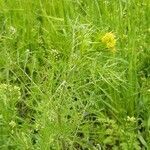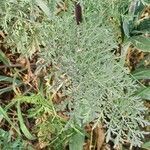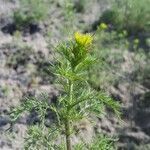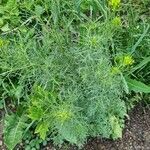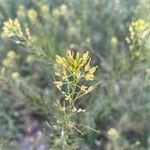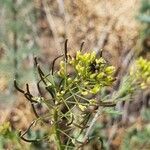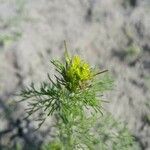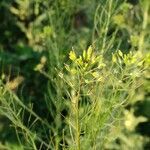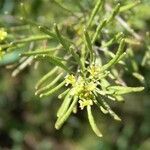Herbs annual, (10-)20-70(-100) cm tall, eglandular, sparsely to densely pubescent with dendritic trichomes, sometimes glabrous distally. Stems erect, simple basally, often branched above. Basal and lowermost cauline leaves 2-or 3-pinnatisect, ovate or oblong in outline, to 15 × 8 cm; petiole 0.1-2(-3) cm; leaf blade ultimate division linear or oblong, entire, acute to 10 × 2 mm. Upper cauline leaves sessile or shortly petiolate, smaller and often with narrower ultimate lobes, often glabrous. Fruiting pedicels (0.5-)0.8-1.5(-2) cm, slender, much narrower than fruit, straight, divaricate or ascending. Sepals yellowish, oblong-linear, 2-2.5 × ca. 0.5 mm. Petals yellow, narrowly oblanceolate, 2-2.5 × ca. 0.5 mm; claw 1.5-2 mm. Filaments 2-3 mm; anthers ca. 0.5 mm. Ovules 20-40 per ovary. Fruit narrowly linear, (1.2-)1.5-2.7(-3) cm × 0.5-0.8(-1) mm; valves glabrous, torulose, with a prominent midvein; septum with a broad central longitudinal band appearing as 2 or 3 veins; style obsolete or to 0.2 mm. Seeds reddish brown, oblong, 0.7-1 × 0.3-0.6 mm. Fl. and Fr. Apr-Jun. 2n = 28*.
Annual herb. Rosette short-lived or 0. Stem sometimes purplish, erect, stellate-hairy, to 1 m tall. All lvs ± densely stellate-hairy, 2-3-pinnatisect, glaucous, 2-7 × 1-3 cm; lobes linear or narrowly oblong. Racemes erect or suberect, sparsely hairy or glabrous, 10-30-(40) cm tall. Pedicels slender, c. 5 mm long at flowering, lengthening to 1-(2) cm and spreading at fruiting. Sepals c. 2 mm long, clothed in stellate hairs. Petals pale yellow, 1-1.5 mm long. Anthers 0.2-0.3 mm long; filaments slightly > sepals. Silique ± erect, glabrous, often curved upwards making an angle with the pedicel, (10)-15-20 × c. 1 mm, slightly torulose; median vein distinct. Seeds oblong, brown, c. 1 mm long, in 1 row per locule.
Erect branched annual herbs 0.3-1 m high. Stem densely stellate-pubescent below, sparsely in the upper part. Leaves up to 12 cm long, finely 2-3-pinnatisect with 6-9 pairs of primary pinnae; lobes narrowly oblong, rounded; lower leaves petiolate, upper leaves sessile; densely stellate-pubescent. Racemes terminal, many-flowered; rhachis puberulous; buds narrow, clavate. Sepals 2-2.5 mm long, linear-oblong puberulous. Petals c.2 mm long, linear-spathulate, whitish or yellowish. Stamens distinctly exserted; filaments about 3 mm long. Siliquae 1-2 cm long, 0.5-0.8 mm broad, linear, torulose, on pedicels c. 1 cm long (in the South African material); stigma small, subsessile.
Plants slender, erect, 15–100 cm tall, hairy at least basally with stellate hairs. Leaves bi-or tri-pinnatisect, with 6–9 pairs of primary pinnae, the segments linear. Inflorescence a dense raceme. Sepals 2–2.5 mm long. Petals 2–2.5 mm long, equal or shorter than sepals, pale yellow. Stamens exceeding sepals. Stigma sub-sessile. Siliqua linear, 8–44 mm long, 0.5–1 mm wide, terete, curved; valves somewhat tuberculate, reticulate veined; pedicels slender, erect to spreading, 5–50 mm long. Seeds ovoid, 1–1.5 mm long.
Annual herb, 0.1-1.0 m high; erect, branched. Stem stellate-pubescent below, sparsely in upper part. Leaves: lower leaves petiolate; upper sessile, 2-or 3-pinnatisect, 6-9 pairs of primary pinnae; lobes narrowly oblong, stellate-pubescent. Inflorescence a many-flowered, terminal raceme; rachis puberulous. Sepals linear-oblong, puberulous. Petals whitish or yellowish, linear-spathulate. Stamens exserted. Fruit a linear siliqua, torulose, pedicellate.
Annual, 0.3-1 m tall, stem densely stellate-hairy below. Leaves finely 2-or 3-pinnatisect, with 6-9 pairs of primary lobes, densely stellate-hairy. Flowers minute, whitish or yellowish. Fruit linear, 10-20(-45) x 0.5-0.8 mm, ± knotted along length. ?Flowering time.
A cabbage family herb. It is an annual or biennial plant. It is almost 0.4-1 m high. The leaves do not have stalks. They are narrow, oblong and taper towards the tip. The flowers are yellow. The fruit is a pod. It is narrow. The seeds are 1 mm long by 0.5 mm wide.
